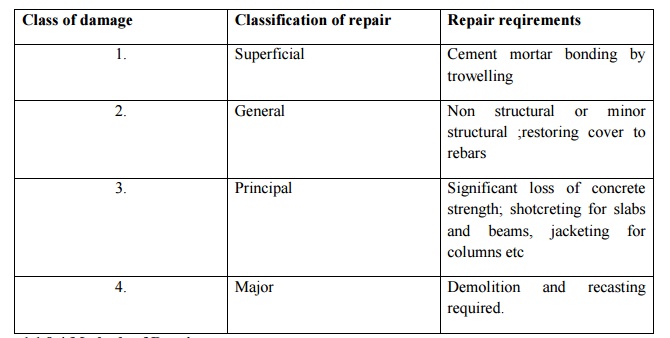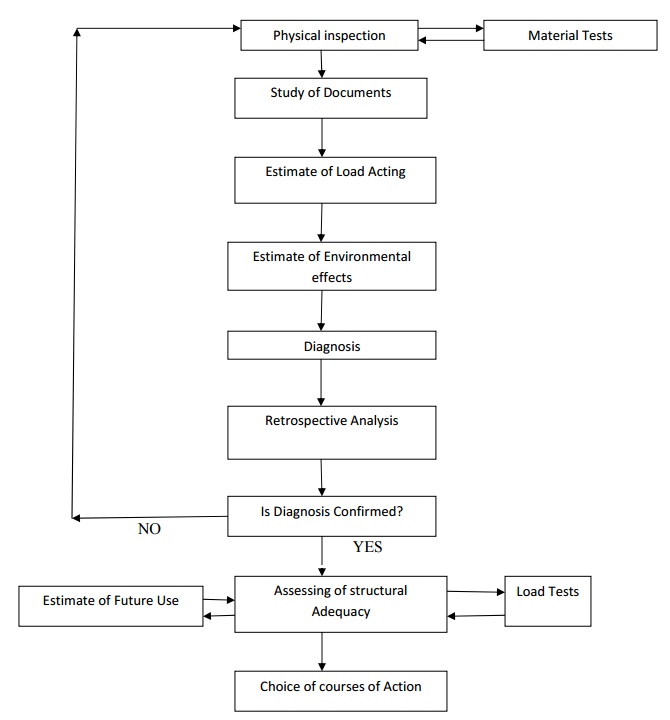Chapter: Civil : Repair and Rehabilitation of Structures : Maintenance and Repairs Strategies
Repair and Rehabilitation of Structures: Maintenance and Repairs Strategies
MAINTENANCE AND REPAIRS STRATEGIES
Maintenance, repair and
rehabilitation, Facets of Maintenance, importance of Maintenance Various
aspects of Inspection, Assessment procedure for evaluating a damaged structure,
Causes of deterioration
Maintenance
Maintenance Engineering is
defined as the work done to keep the civil Engineering structures and work in
conditions so as to enable them to carry out the functions for which they are
constructed.
It is preventive in nature.
Activities include inspection and works, necessary to fulfill the intended
function, or to sustain original standard of service.
Scope of maintenance
ü Petty
repairs, replacements and structural repairs of buildings, white and color
washing, distempering and painting at prescribed intervals
ü Repair
and renewal of furniture
ü Operation,
periodical maintenance, repairs renewals of machinery and equipment for
electric etc
ü Repair of
roads,culvets and resurfacing the roads
1.Facts of Maintenance
Aims of
Maintenance work classified as
ü The
avoidance of accidents, which may harm people or plant
ü The
continued operation of a facility
ü The
protection of the capital investment in the asset
2.Maintenance work is classified
as
ü Preventive
maintenance
ü Remedial
maintenance
ü Routine
maintenance
ü Special
maintenance
§ Maintenance work is classified as
The maintenance work done before the defects occurred in the
structure is called preventive structure
2.1.Remedial maintenance
It is the maintenance done after the defects in the structure.
It involves the following basic steps.
ü Finding
the deterioration
ü Determining
the clause
ü Evaluating
the strength of the existing structures
ü Evaluating
the need of the structures
ü Selecting
and implanting the repair procedure
2.2.Routine maintenance
It is the service maintenance attended to the structure
periodically. It is depends upon specifications and materials of structure,
purpose, intensity and condition of use.
2.3.Special maintenance
It is the work done under special condition and requires
sanction and performed to rectify heavy damage.
3.Importance of Maintenance
various aspects of Inspection
ü Improves
the life of structure
ü Improved
life period gives better return on investment
ü Better
appearance and aesthetically appealing
ü Leads to
quicker detection of defects and hence remedial measures
ü Prevents
major deterioration that leads to collapse
ü Ensures
safely to occupants
ü Ensures
feeling of confidence by the user
Daily Routine Maintenance
ü Basically
an inspection oriented and may not contain action to be taken
ü Help in
identifying major changes, development of cracks, identifying new cracks etc
ü Inspection
of all essential items by visual observation
ü Check on
proper function of sewer, water lines, wash basins, sinks etc
ü Check on
drain pipes from roof, during rainy season
Weekly Routine Maintenance
ü Electrical Accessories
ü Flushing sewer line
ü Leakage of water line
Monthly Routine Maintenance
ü Cleaning Doors, windows, etc
ü Checking Septic Tank/Sewer
ü Observation for cracks in the
elements
ü Cleaning of overhead tanks
Yearly Routine Maintenance
ü Attending
to small repairs and white washing
ü Painting
of steel components exposed to weather
ü Check of
displacements and remedial measures
Stages of inspection
A. Inspection
Collect
data at specified intervals in specified form
B. Analysis
Add latest information to database
ii.
Examine progression of defects
iii.
Relate defects to action criteria
C. Action possibilities
i.
Note and wait for the next inspection
ii.
Alter inspection frequency
iii.
Institute repairs
iv.
Further detailed investigation
v.
Put safety procedures in place
5.Necessitation of the maintenance
The causes which necessitate the
maintenance effects the service and durability of the structure as follows:
ü Atmospheric
Agencis
ü Normal
wear and tear
ü Failure
of structure
5.1 Atmospheric Agencis
Rain: It is the
important source of water which affects the structure in the following ways:
Expansion And contraction
ü The
material is subjected to repetitive expansion and contraction while they become
wet and dry and develops the stresses
ü Dissolving
and carrying away minerals as it is universal solvent
Chemical: The water
available in nature contains acids and alkali and other compound in dissolved
form acts over the material to give rise, which is known as chemical
weathering.
i.
Wind:It is the agent, which
transports the abrasive material and assists the physical weathering.
ii.
Temperature: The diurnal, seasonal
and annual variation of the temperature, difference in temperature it
causes expansion and contraction.
5.2.Normal wear and tear
During the use of structure it is
subjected to abrasion and thereby it looses appearance and serviceability
5.3 Failure of structure
ü Improper
design- Due to incorrect, insufficient data regarding use, loading
and environmental conditions, selection of material and poor detailing.
ü Defective
construction-poor materials, poor workmanship, lack of quality
control and supervision.
ü Improper
use of structure- overloading, selecting the structure for the use
they not designed impurities from industrial fuel burning, sea water
minerals etc.
6.Inspection periods
ü Pre-monsoon
period
ü Monsoon
period
ü Post-monsoon
period
6.1 Pre-monsoon period
To decide the maintenance programmer to be done
before monsoon such as cleaning of drains, checking of roof leakage, collection
material etc
6.2Monsoon period
It is needless to mention that
the emergency work carried out in monsoon period.e.g: railway tracks, collapse
of roof etc.
6.3 Post-monsoon inspection
It is made to repair the damage
caused by water and draw up the programme of repair according to the
priorities.
7.Maintenance processes
ü Design
for maintainability
ü Preventive
maintenance
ü Predictive
maintenance
ü Reliability
centered maintenance
ü Reactive
maintenance
ü Spares
management
ü Maintenance
logistics support
ü Total
productive maintenance
ü Organizing
for maintenance
ü Computerized
maintenance management program
ü Statutory
requirements
8.Inspection of building
ü Condition
of wall paint
ü Condition
of paint on woodwork and grill
ü Condition
of flooring
ü Roof
leakage, leakage etc
ü Condition
of service fittings
ü Drainage
from terrace
ü Growth of
vegetation
ü Structural
defects like Crack, Settlement, and Deflection
9.Repair and rehabilitation
Repair is the technical aspect of
rehabilitation. It refers to the modification of a structure, partly or wholly
which is damaged in appearance or serviceability.
The following factors to be considered repair of
concrete structures:
ü The cause
of damage
ü Type,
shape and function of the structure
ü The
capabilities and facilities available with builders
ü The
availability of repair materials
9.1Stages of concrete repair
Repair of concrete structures is
carried out in the following stages:
ü Removal
of damaged concrete
ü Pre
treatment of surfaces and reinforcement
ü Application
of repair material
ü Restoring
the integrity of individual sections and strengthening of structure as a whole
9.2
Repair procedure
A repair
procedure may be selected to accomplish on or more of the following objectives:
ü To
increase strength or restore load carrying capacity
ü To
restore or increase stiffens
ü To
improve functional performance
ü To
provide water tightness
ü To
improve durability
ü To
prevent access of corrosive material to reinforcement
9.3 Types and classification of repair Types of
repair:
ü Cosmetic
treatments on surfaces
ü Partial
replacement of surface and subsurface material
ü
Additional of reinforcements and bonding materials
to strengthen the element
ü
Total replacement of the structural element
Classification of repair:

Classification
of repair : Repair reqirements
Superficial
: Cement mortar bonding by trowelling
General
: Non structural or minor structural
;restoring cover to rebars
Principal
: Significant loss of concrete strength;
shotcreting for slabs and beams, jacketing
for columns etc
Major :
Demolition and recasting required.
![]()
![]()
![]()
![]()
![]()
![]()
![]()
![]()
![]()
![]()
![]()
![]()
![]()
![]()
![]()
![]()
![]()
![]()
![]()
![]()
![]()
![]()
![]()
![]() 9.4 Methods of Repairs
9.4 Methods of Repairs
The
following considerations are to be taken care of and observed:
ü Determination
of extent, location and width of cracks
ü Classification
of cracks as structural and non-structural
Dormant cracks:
Dormant cracks are caused by some event in the part, which is
not expected to recur. They remain constant in width, and may be repaired by
filling then with a rigid material.
Active cracks:
Do not remain constant in width, but open and close as the
structure in loaded, or due to thermal and hydras changes in the concrete.
Growth cracks:
Increase in width becomes the
original reason for their occurrence persists.
9.5 Applications:
The repair of cracks can be achieved with the
following techniques:
ü Resin
injection
ü Routing
and Sealing
ü Stitching
ü External
stressing
ü Bonding
ü Blanketing
ü Overlays
ü Dry pack
ü Vacuum
impregnation
ü Polymer
impregnation
9.6 Rehabilitations
The success of repair activity
depends on the identification of the root cause of the deterioration of the
concrete structures. The repairs can be done for the improvement of strength
and durability, thus extending the life of the structure, is not difficult to
achieve.
It is the processes of restoring
the structure to service level, once it had and now lost, strengthening
consists in endowing the structure with a service level, higher than that
initially planned by modifying the structure not necessarily damaged area.
The following steps are generally
used in the rehabilitation of distressed concrete structure:
ü Support
the structural members properly as required.
ü Remove
all cracked, spalled and loose concrete.
ü Clean the
exposed concrete surfaces and steel reinforcement
ü Provide
additional reinforcing bars, if the loss in reinforcement is more than 10%
ü Apply
protective coatings over the exposed/repaired surface.
9.6.1 Applications:
ü Shotcrete/Gunite
ü Resin
injection
ü Dry pack
and Epoxy-bonded dry pack
ü Slab
jacking Technique
ü Sprayed
concrete
10Assessment procedure for
evaluating a damaged structure The following steps may necessary:
ü Physical
Inspection of damaged structure
ü Prepartion
and documenting the damages
ü Collection
of samples and carrying out tests both in-situ and in lab
ü Studying
the documents including structural aspects
ü Estimation
of loads acting on the structure
ü Estimate
of environmental effects including soil structure interaction
ü Diagnosis
ü Taking
preventive steps not to cause further damage
ü Retrospective
analysis to get the diagnosis confirmed
ü Assessment
of structural adequacy
ü Estimation
on future use
ü Remedial
measures necessary to strengthen and repairing the structure
ü Post
repair evaluation through tests
ü Load test
to study the behavior
ü Choice of course of action for the restoration of structure.
10.1Flowchart for Assessment
procedure for damaged structure

11Causes of Deterioration
a) Design and construction Flows
Design of concrete structures
governs the performance of concrete structures. Well-designed and detailed
concrete structure will show less deterioration in comparison with poorly
designed and detailed concrete, in this similar condition. The beam-column
joints are particularly probe to defective concrete, if detailing and placing
of reinforcement is not done properly.
b) Environmental effects
Micro-cracks present in the
concrete are the source of access of moisture and atmospheric carbon-di-oxide
into the concrete, which attack reinforcement and react with various
ingredients of concrete. In aggressive environment, concrete structures will
deteriorate faster and strength/life of concrete structures will be severely
reduced.
c) Usage of poor Quality Material
Quality of materials to be used
in construction, should be ensured by means of various tests, as specified in
the IS codes. Alkali-aggregate and Sulphate attack results in early
deterioration. Clayed materials in the fine aggregates may weaken the
mortar-aggregate bond, and reduce the strength.
d) Quality of Supervision
Construction work should be
carried out as per the specifications. Adherence to specified water-cement
ratio controls strength, permeability and durability of concrete. Insufficient
vibration may result in porous and honey-combed concrete, whereas excess
vibration may cause segregation.
e) Deterioration due to Corrosion
ü Spalling
of concrete cover
ü Cracks
parallel to the reinforcement
ü Spalling
at edges
ü Swelling
of concrete
ü Dislocation
Related Topics